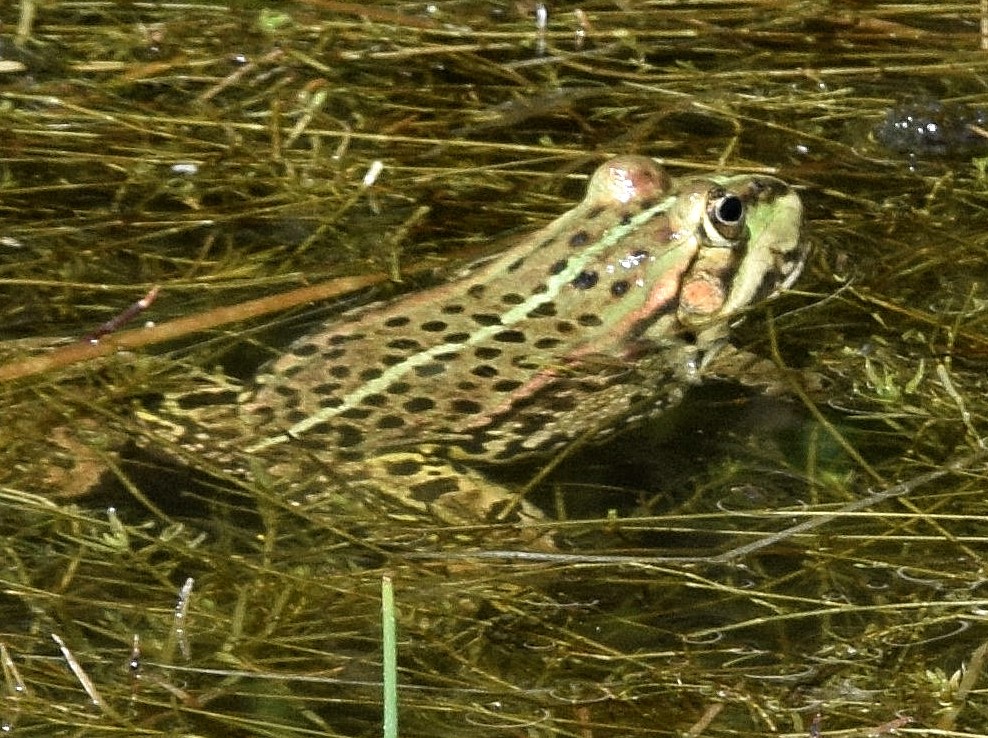This was my second new Amphibian target for the current year. I had planned to seek them out in the Norfolk Brecks given a suitable weather window, but when Ewan told me they also thrive at a location just 33 miles from home that seemed an easier option. I met him there at 9:30 am on this fair weather morning, and the objects of our intent did not disappoint.
There was long considered to be just one native British Frog, the Common variety, but this post’s subject is now generally accepted as a second (see here) that had become extinct. There have also been introductions of two other continental European species of the genus Water Frogs. This began in the early 19th century when Edible Frogs were released in the Fens, to largely die out by 1914, though there were more imports across south-east England later in the 20th century. The closely-related Marsh Frog was first introduced at Romney Marsh, Kent in 1935, since when they have been credited with penetrating other south-eastern counties.
Similarly re-introduced Northern Pool Frogs had largely died out by the mid-1990s, but new East Anglian releases of stock from Sweden by ARC and partner organizations took place between 2005 and 2015. Elsewhere there have been unofficial imports of non-native, southern European Pool Frog sub-species. Exactly where the Greenham Common cluster fits in with all that I am not sure, though my research for this post suggests it derives from the latter. There is great variation in colouring and patterning so separation of different populations in the field must be nigh on impossible.
Pool Frogs are generally smaller than their mature Common counterparts and produce just 25% of the latter’s tadpole count. Spawning commences with the onset of warm weather in May, three months later than Common Frog, and Pool bask semi-submerged through sunny days as we witnessed here. Around 20 minutes after my arrival at a pond to the immediate west of the BBOWT reserve’s control tower (RG19 8DB – SU 499650), there was a sudden crescendo of croaking, but not for long and thereafter it was merely intermittent.





The different individuals we observed today (pictured above) exhibited variable green or brown ground colouring overlaid by well-defined dark spots, with a prominent pale green or yellowish stripe along the centre of their backs. Pool also have more pointed snouts and longer legs than Common Frogs. Males call by day in close-knit groups, with up to 10 within a square metre of water. Their spawn rafts are typically smaller than those of the Common Frog, individual eggs being brown above and yellowish below. There was certainly none of the breeding frenzy here that we witnessed with Common Frog two years ago (see here).
Pool Frogs have a restricted distribution within the five northern European countries where they occur as small populations, some of which are in decline. Even where they are stable, their limited distribution and numbers make them vulnerable to the impact of habitat loss, severe weather and disease. I have recorded both Marsh and Edible Frog previously abroad, and now the third of their Water or Green Frog group is a lifer, whatever the provenance of this post’s sightings today might be. The British Pool Frogs of centuries long past were the northern sub-species now re-established by ARC in the Brecks (see here), so as an unlicensed introduction the Greenham Common colony will be classed as non-native.
We were not the only outsiders taking an interest in the local Pool Frog resource today. The swimming Grass Snake (pictured above) is one of their main predators, though it was not an especially large one. Another is Herons that are no respecters of scarcity themselves. But nothing else disturbed the tranquility of either the observed or the observers. Fortunately we encountered no stick throwing doggy game enthusiasts on this occasion. And so the languid life forms of our scrutiny continued to laze their own time away, croaking occasionally.
Before leaving site we listened to the song of a Nightingale issuing from a reserve perimeter hedge, one of Greenham Common’s specialty birds; others being Dartford Warbler, Woodlark and Nightjar. I have also been here in the past for butterflies, Odonata and Autumn Ladies Tresses Orchids. The mystery remains as to how this latest item got here, since I can find no reference to it online (advice in comments, anyone?). And today’s experience was one more affirmation of the now naturalised former military airfield’s great biodiversity.


